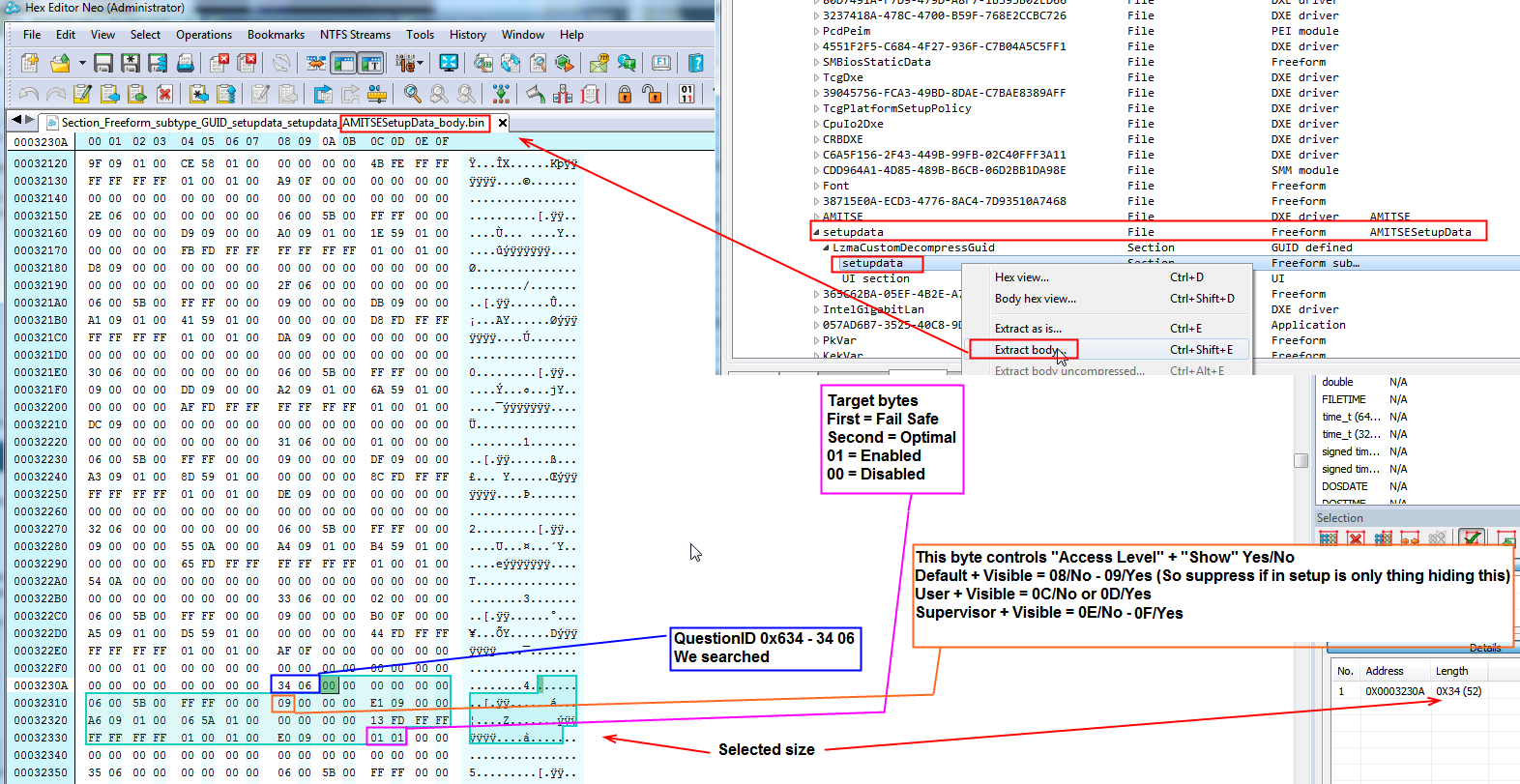ich hab noch kein plan ob ich "Suppress If" die auschalten muss oder "Acess Level" nur ändern

, ich hab einfach mal meine Bios Daten angehängt viel leicht weis es ja jemand

Aptio V UEFI Editor: an alternative to AMIBCP

boringboredom.github.io
Anleitung:
Lost_N_Bios Post:
On editing the setup PE32, I don’t know how to edit for this issue to fix either, this error is not same as the others you linked where a string total amount is exceeded
The error you have means there is too many forms (actual BIOS menus/submenus/pages etc), so you can’t easily just remove some of those and it be OK.
I can disable HPET for you, on Spread Spectrum what do you mean “every setting” Normally if you disable spread spectrum it’s disabled
For these settings, there is three main possible places to change them to enabled/disabled, and some BIOS use one or the other so you may need to disable in all areas or possibly only one, but you’d have to test one by one to find out which is used or just set them all at once.
Those are setup module, AMITSE/SetupData module (This is what AMIBCP changes), and finally NVRAM. NVRAM can have multiple volumes at top of BIOS (usually 1-2) and then 1-2 more in other BIOS volumes, usually at least one in same volume as setup module, and then 1-2 others at last volume.
And those NVRAM may not always hold same setting values as you search them out, so it’s tricky to mod sometimes
Setup edit is easy, you find the setting string in hex from the IFR, then you change which setting is default via hex. Here is example from IFR for your BIOS
One Of: High Precision Timer, VarStoreInfo (VarOffset/VarName): 0xA86, VarStore: 0x1, QuestionId: 0x634, Size: 1, Min: 0x0, Max 0x1, Step: 0x0 {
05 91 E0 09 E1 09 34 06 01 00 86 0A 10 10 00 01 00} << Search this string on PE32 module, edit as below
One Of Option: Disabled, Value (8 bit): 0x0 {09 07 04 00
00 00 00}
<< replace 00 in bold here with 30
One Of Option: Enabled, Value (8 bit): 0x1 (default) {09 07 03 00
30 00 01}
<< This 30, move to above at same position, replace here with 00 - this is what controls "Default"
Actually, can you see “PCH Configuration” page in your BIOS at Advanced section? If yes, you can easily make this setting visible to you as well (This may require setup only edit, or setup + AMIBCP Access Level (AMITSE/SetupData Instead))
Setup edit is simple, unsuppress by making this edit, then it will be visible in BIOS unless setupData also needs edited to change access level to User/Supervisor (Which I didn’t show below
) - Added info pre-post, but it’s already set to visible by default there
Due to checking all this, I now can answer myself at above question, no you cannot see PCH Config on Advanced BIOS page
Suppress If {0A 82}
True {
46 02}
<< Change this to 47 02 (= false)
One Of: High Precision Timer, VarStoreInfo (VarOffset/VarName): 0xA86, VarStore: 0x1, QuestionId: 0x634, Size: 1, Min: 0x0, Max 0x1, Step: 0x0 {
05 91 E0 09 E1 09 34 06 01 00 86 0A 10 10 00 01 00} << Search this string on PE32 module, directly in front of it you will see above edit
One Of Option: Disabled, Value (8 bit): 0x0 {09 07 04 00 00 00 00}
One Of Option: Enabled, Value (8 bit): 0x1 (default) {09 07 03 00 30 00 01}
Now, to edit AMITSE/SetupData, find this in main BIOS volume (Same one that contains setup), it’s usually near the bottom of the volume and often directly below AMITSE module.
Make sure you are extracting AMITSE/SetupData (body). You may need to look at BIOS side by side in UEFITool NE and regular, sometimes the AMITSE/SetupData module (at least SetupData itself) is not shown by name in regular UEFITool.
This side by side comparison will help you make sure you are extracting and replacing the correct module. I always use NE version for all inspections, extractions etc, it’s just easier to find due to often giving more info/names etc, and it auto gives you the correct name in full when you extract too
Once you’ve extracted the SetupData body, edit using info below
Using same setting as above for this example >> One Of: High Precision Timer, VarStoreInfo (VarOffset/VarName): 0xA86, VarStore: 0x1,
QuestionId: 0x634 << this is what we’ll hunt down here (backwards in hex so = 34 06)
Open the SetupData body module in hex, search (Find all) that QuestionID backwards in hex 34 06, last result will hold the failsafe/optimal settings that you change in AMIBCP. The setting bytes are 34 bytes past the ID, so bytes 33 and 34 are Failsafe/Optimal
To change “Access Level” is 0xF (15) bytes past the ID >> Type - Access Level / Show Yes/No - DEFAULT = 00/No - 01/Yes (08/No - 09/Yes) USER= 04/No - 05/Yes (or 0C/No - 0D/Yes) Supervisor= 06/No - 07/Yes (Or 0E/No - 0F/Yes)
Default = 29 (Yes) / 28 (NO) / User = 2D (Yes) / 2C (NO) / Super/Admin = 2F (Yes) / 2E (NO)
Here is image example of this for the above setting, both are currently set to 01 (enabled)
NVRAM edit is too many areas and too involved to explain/show without making out an in-depth guide. Hopefully you will not need this.
If you do all of above and it still is enabled, then let me know and I can mod the NVRAM for you



















